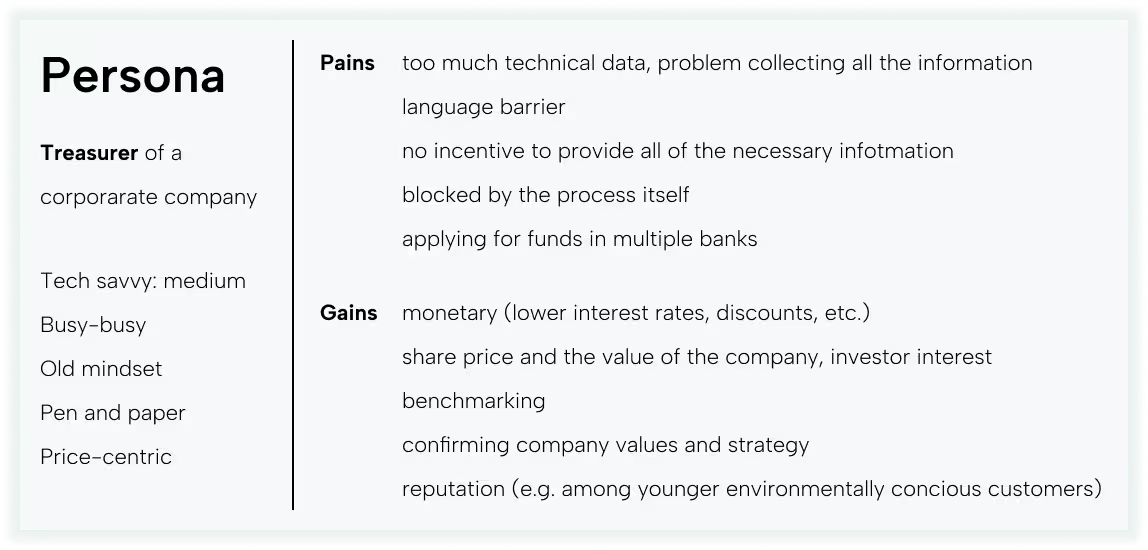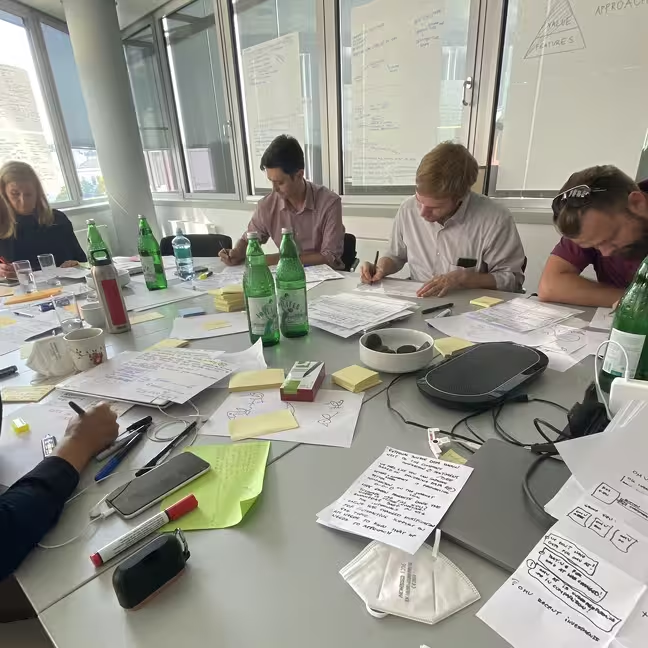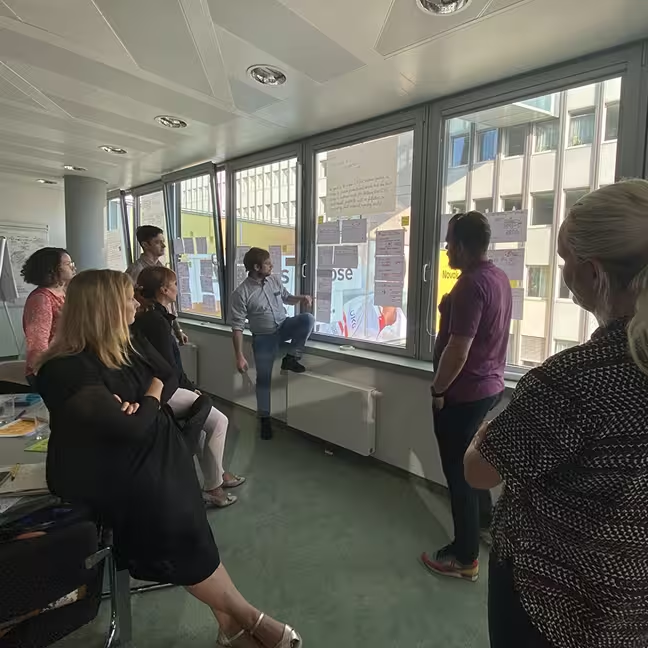Design Sprint : Digital ESG platform
Early stages of developing a digital ESG process for Raiffeisen Bank International.

My Role
- Facilitator
The Team
- 8 people
- various departments
My Contribution
- Project management and coordination
- Workshop preparation
- Workshop facilitation
- Wireframing, usability testing
- Documentation and debriefing
Tools Used
- Sketch
- Invision
- Craft
- Workshop materials
Project Span
- 1 week workshop
- 3 weeks preparation
Design Sprint Schedule
Monday
- "Understanding"
- Defining sprint goals
- Expert interviews
- How Might We's
- User journey mapping
Tuesday
- "Defining"
- Lightning demos
- Sketching
- Crazy 8s
Wednesday
- "Deciding"
- Art gallery and voting
- Story boarding
Thursday
- "Prototyping"
Friday
- "Testing" with target customers
Problem
How to build a software solution that supports various departments when assessing the ESG score for a customer?
At Raiffeisen Bank, I am a part of a dedicated team that is digitalizing the most important existing bank processes for corporate clients, to keep up with the fast-paced fintech scene. One of these processes is the ESG (Environmental, Social, and Governance) process through which clients (e.g. a large clothing brand) apply for loans with better rates to fund their sustainable projects. Due to an NDA, I cannot share the final designs of the project, but I can describe the process and my work.
Solution
Facilitate a 5-day design sprint to enable the departments to collaborate and conclude with a validated ESG concept.
The ESG topic is very broad, complex, and includes many different departments and stakeholders. It was evident to me that coordinating and making progress with so many moving parts is going to be extremely time-consuming within a normal corporate setting. This is why I wanted to try a focused 5-day design sprint approach.
Additionally, according to research, a design sprint can yield a 7x savings in time and 2x savings in money, compared to typical product processes.
Setting the stage
First and foremost it was important to get the design sprint team participants right. I created a stakeholder map and gathered participants from the business side and the development side, making sure we have all of the different departments represented within the sprint. I also identified a decider, who could make decisions and act as a north star for the team.
For several weeks before the workshop, I got together with the decider to already create drafts for the sprint goal, sprint questions, and write down how might we's. These things are meant to be created during the sprint, but I believe it's helpful for the decider, as well as the facilitator, to have some drafts ready in case the team gets stuck. I also mapped out the as-is user journey for the ESG process by discussing the target audience with the sustainable finance department, to help prepare the decider for the workshop and ensure we stay customer-centric.
Finally, after weeks of preparation and negotiation to block a proper meeting room in the bank for an entire week, we could begin on a Monday morning.
What happened during the sprint week
Monday : Understanding
On the first day, we focused on understanding the users, what their needs are, and formulated a strategy to proceed. This included defining a long-term goal while being very optimistic, listing pessimistic questions about what might go wrong, defining the persona we are focusing on, and mapping out their user journey, in which we circled the steps which we set out to tackle within the sprint. I also scheduled 3 interviews with other ESG experts, who did not fit into the sprint team, but could offer valuable insights to the team through an interview format.
Tuesday : Diverging
Tuesday began with all of the sprint participants presenting solutions from other websites and services that they like and that the rest of the team could get inspired by. Afterward, we divided up parts of our digital ESG approach among the participants and began sketching possible solutions.
Wednesday : Deciding
On Wednesday our workshop room had taken the form of an art gallery, where every participant could study and vote for their preferred sketches. The walls looked like a heatmap after everyone had voted with small sticker dots, and I was able to identify the sketches we will progress with. We created a detailed storyboard by reusing the sketches within the board, which became the base for the prototyping on Thursday.
Thursday : Prototyping
On the day of building the prototype, I gave the sprint team a day off to catch up with their other work. As a user experience designer I need to prepare prototypes daily, therefore I was sure I can quickly build a working prototype by using a pre-built component library in Sketch and mapping the interactions with the Marvel app. By the end of the day, I already tested the prototype with a couple of the sprint team participants to be sure we are ready for usability testing the next day.
Friday : Usability Testing
I had recruited 5 current customers of Raiffeisen Bank, who met the target audience description we had prepared on Monday. All of the sprint team participants had the task of taking notes throughout the usability testing, while I was conducting the interviews in one room and the sprint team was watching the live stream in another room. The prototype got a lot of positive feedback and I saw how the sprint team participants enjoyed the experience of seeing real-time user feedback from actual customers.


HMW
show the customers how they compare to other companies within their industry when it comes to green investments?
HMW
encourage the customers to provide all the data we need to assess their ESG score properly?
HMW
offer benefits to our customers who are on the fence about investing into green bonds with us?

In conclusion
Overall, the design sprint was a huge success. We were able to make so much progress with the sprint team, that would have taken ages to complete in a typical large corporate setup, where everybody's calendars are busy. As a facilitator, I enjoyed seeing the communication and debate between the different stakeholders within the team and trying to always document the discussion on whiteboards, and turn them into actionable points. The experience of facilitating a group of assertive smart people is exhausting, but I would definitely recommend doing it.
At this point, the prototype for the MVP has been updated based on the user feedback received on the last day of the sprint. The ESG project is awaiting the next stage of development, which would be preparing and conducting a big wall session with the development team.